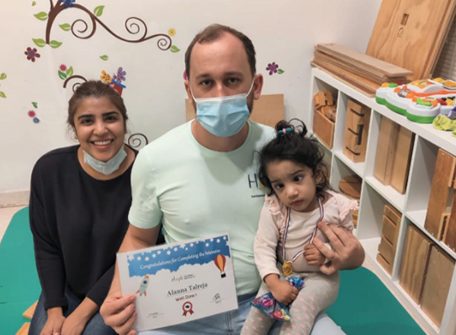What Is Cerebral Palsy?
Cerebral Palsy (CP) is a common congenital disability. It is a group of neurological diseases that make it difficult to move various parts of the body. Injuries to certain parts of the brain can have an effect on both voluntary and involuntary movements.
Cerebral palsy is not contagious, and it does not worsen with age because it is not progressive. According to studies, symptoms in patients suffering from the disease have improved over time. People with cerebral palsy have a normal lifespan and, in many situations, a good standard of health.
Causes of Cerebral Palsy
It is caused by a malformation and/or disruption in brain development, which usually occurs before birth. In numerous cases, the precise cause is yet unknown. The following factors may contribute to cerebral palsy:
- Born before 37 weeks of pregnancy
- Low birth weight
- Gene mutations that cause aberrant cognitive development
- Stroke before, during, or after delivery
- Maternal infections have an impact on the growing fetus.
- Birth asphyxia is less prevalent.
- Seizures at birth or within the first month.
- Jaundice that remains untreated
As previously stated, cerebral palsy does not worsen with age; however, some impairment might become more obvious over time.
Types of Cerebral Palsy
There are four major forms of cerebral palsy, each of which is caused by injury to different brain areas that impede coordination and balance.
- Spastic Cerebral Palsy: The most frequent kind is spastic cerebral palsy. It causes an increase in muscle tone, rigid muscles, and clumsy motions. It can often only impair one area of the body. It can also impact the hands and feet, and face in some situations.
- Dyskinetic Cerebral Palsy: Dyskinetic cerebral palsy is characterized by difficulty in controlling arms, feet, legs, and body movements. This can make sitting and walking difficult.
- Ataxic Cerebral Palsy: Ataxic cerebral palsy refers to the difficulties with postural control.
- Mixed Cerebral Palsy: This implies your child can experience symptoms from more than one category.
Symptoms of Cerebral Palsy
The severity of CP can range from mild to severe. Symptoms include:
- Irregular arm and leg motions
- Feeding difficulties in a child
- Poor muscular tone early in life
- Delayed development of walking and speech
- Unusual body posture
- Muscle cramps
- Body rigidity
- Poor balance
- Crossed eyes
Children with spastic CP have tight muscles and stiff motions, particularly in the legs, arms, and back. Because CP affects the entire body, children struggle with postural control. They have slow, uncoordinated motions and a low muscular tone, making it difficult for them to sit upright and walk. The signs of mixed CP are a mix of the two types.
Children with CP may also have learning, listening, or vision impairments, as well as mental disabilities.
How Is Cerebral Palsy Diagnosed in A Child?
A kid is usually diagnosed with CP when he or she is between the ages of 6 and 12 months. A child must be reaching developmental stages at this age. These include sitting, standing, walking, and controlling one’s hands and head. Your child’s behavior and medical history will be discussed with the medical provider. They will perform a physical examination on your youngster.
Your child may also be subjected toCP testing such as:
- Nervous System Test: A nervous system test evaluates a child’s responses, brain function, and motor performance.
- MRI: While this imaging test can help analyze the anatomy of the developing brain, it cannot always determine how well the brain is functioning.
- Feeding Studies: These examinations employ X-rays or scans to examine what happens between the time food reaches your child’s mouth and the time they swallow.
- Electroencephalogram (EEG): A set of electrodes will be attached to the child’s scalp to detect electrical energy. A doctor determines that a youngster has epilepsy because of the association between cerebral palsy and epilepsy. Using this examination, the likelihood of a cerebral palsy diagnosis rises.
- Gait Lab Analysis: Electrodes and reflective markers are placed on the youngster to measure muscle activation and monitor mobility of body parts during gait lab study.
- CT Scan: This procedure is used to aid in the diagnosis of cancers, explore internal bleeding, and check for other internal injuries or damage. It is also utilized for tissue or fluid biopsies.
- Genetic Studies: DNA sequences are examined in Gene testing to discover abnormalities (gene mutations) that can trigger any genetic condition.

Metabolic Tests: It provides information on the body’s electrolyte levels or fluid balance, such as salt and potassium, and how well the kidneys function.
Can Cerebral Palsy Be Treated?
Cerebral palsy cannot be cured, and its effects are permanent. However, there is a lot that can be done to strengthen a child’s strength and mobility. The purpose is to help children become as self-sufficient as possible.
Therapies for Cerebral Palsy Children
- Physical Therapy
This may enhance motor control and walk of cerebral palsy children, especially if therapy begins early. Speech therapy may improve speech clarity and assist with swallowing issues.
- Constraint-Induced Movement Therapy
This might be useful if the condition did not impact all limbs. During this therapy, the healthy limbs are restricted and saved for specific tasks so that children must complete activities with the impaired limb.
As a result, new nerve impulse pathways in the brain may form, allowing the kid to utilize the damaged limb more effectively.
- Occupational Therapy
Occupational therapists can help certain children learn how to compensate for muscle deficits and thus complete daily activities on their own. Alternatively, therapists may teach youngsters how to use technologies that would also assist them in performing these tasks.
- Medications
Cerebral palsy drugs come in various forms that can help treat the condition, such as seizures and stiffness. Since each child is different, the use of drugs may alter depending on a child’s predominant symptoms.
- Surgery
Surgery is just one of the many choices for helping children with cerebral palsy enhance their movement, posture, and development. Before surgery, most physicians advise parents to undergo medicines and physical rehabilitation. Surgery can help children improve their movement and alignment of the legs, feet, ankles, hips, arms, and wrists.
Home Care for Kids with Cerebral Palsy
A kid with cerebral palsy c have substantial physical needs based on the degree of their disease. Parents will confront unanticipated challenges in securing the care their child demands. Here are some of the precautions that a parent of a kid with cerebral palsy must take:
- Recognize and understand that your child’s impairment can be challenging.
- Use polite and honest language to describe as much about the impairment as possible so that a youngster is not scared of change.
- Make sure your child understands his/her strengths as well as their potential to grow and discover new things.
- Include your infant in your daily activities. Read stories and rhymes to your baby, and encourage them to participate by talking and touching objects with you.
- Use simple toys and objects, demonstrate how to play with them to your baby, and talk to your baby about your play.
- Ensure that your child knows that having cerebral palsy is not their fault.
If your child’s condition deteriorates, contact your doctor as soon as possible.
Looking Ahead
Indeed, living with children suffering from cerebral palsy can be challenging, and the cerebral palsy condition also differs for every child. To help your kid learn and move as much as possible, you need to work closely with the physician to develop an appropriate treatment plan.
Hope AMC is Dubai’s one of the best pediatric rehabilitation centers. We offer pediatric therapy programs for children with cerebral palsy and other neurological disorders. Children’s strength, gross motor abilities, coordination, flexibility, balance, and sensory integration are all improved with our pediatric physical therapy programs.
Consult our pediatric physical therapists today.



